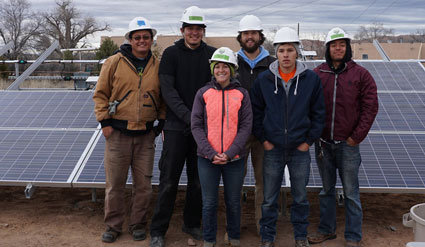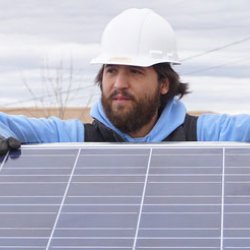On a cold, January day, as smoke from wood fires filled the air, five young AmeriCorps members were hard at work digging a trench in front of a home in the Tesuque Pueblo in the mountains of Northern New Mexico. Fellows with GRID Alternatives, the workers were getting ready to install the community’s very first solar electric system for a family of seven. All save one were themselves Native American, coming from tribes across the United States to both learn the solar trade and serve communities like the ones they came from.
The AmeriCorps-funded SolarCorps program is GRID’s most intensive job training program, providing year-long paid service learning opportunities for people exploring solar careers. For Native Americans from more remote regions with little or no solar industry, the program is an ideal way to get hands-on, in-depth solar PV training. And through GRID’s National Tribal Program, that training is happening on tribal lands.
Austin Thompson, a member of the Eastern Band of Cherokee, started with GRID’s tribal program in 2015, after earning an associates degree in solar PV and NABCEP certification. Following his SolarCorps year, he was promoted to Solar Installation Supervisor. He was joined in September 2016 by two more SolarCorps fellows, Krystian Fragua from Jemez Pueblo, New Mexico and Nick Aberle from the Forest Lake Chapter of the Navajo Nation in Arizona.
Wyatt Atkinson, a SolarCorps working for GRID’s Bay Area office on the north coast of California, also joined the group for the Tesuque installation. A U.S. Navy Veteran and member of the Assiniboine and Sioux tribes of the Fort Peck Indian Reservation in Montana, Wyatt has dreams of bringing solar back home to his people. “As part of my end goal, I plan on going back to my own reservation and helping them achieve energy sovereignty,” he says.
 Austin, Nick and Wyatt all got their start with GRID as volunteers. Joining the SolarCorps program has helped them deepen their learning and develop the skills they will need to work in the industry or even start their own companies.
Austin, Nick and Wyatt all got their start with GRID as volunteers. Joining the SolarCorps program has helped them deepen their learning and develop the skills they will need to work in the industry or even start their own companies.
Being able to bring solar power and solar job training to tribes in the process of gaining their own skills is a powerful motivator for the fellows. Many of GRID’s tribal partners are looking to become energy independent and form their own utilities, and having local expertise is paramount.
“One of GRID’s main missions is developing a workforce,” said Wyatt. “If we want energy sovereignty on tribal lands, it needs to be tribal members that are spearheading that workforce, creating our own companies, creating our own jobs.”
“Helping build these skills within the community is invaluable to the tribe - it provides jobs, it saves them money, and they use a technology that is clean and renewable,” said Berlyn Hubler, a SolarCorps fellow with GRID’s Tribal Program since 2016. Though not Native American herself, she has a deep commitment to the work. “These systemic benefits are what keep me passionate about working with tribes,” she says.
As they laid the wiring in the trench for the ground-mount system in Tesuque Pueblo, the camaraderie among the fellows was palpable, with conversation ranging from favorite NFL teams to cultural jokes to Star Wars and back again. It was the first time they had all worked together on a project and their presence was inspiring to the whole community.
“I think it’s very good for the young people to learn what needs to be done in the future and to see them going out and learning about solar,” said Mrs. Dorame, the homeowner. “And it’s young Indian people, Native Americans, they’re the ones trying to do something here.”
“We’re all from different reservations, but we all have the same goal to help out and give back to our communities,” said Wyatt. “Being able to connect with other people out in Indian Country is a very valuable resource. I assume I’ll know these guys the rest of my life and be able to make other things happen.”

